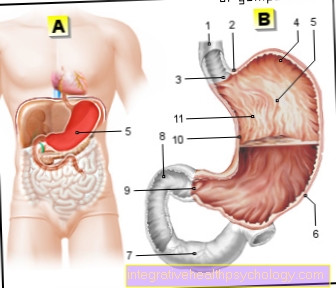Paradoxical embolism
definition
A paradoxical embolism has the same basic structure as a normal venous embolism with a special feature or deviation. An embolism is a sudden blockage of blood vessels caused by a plug (Embolus). This was washed up by the bloodstream (via the venous blood). Mostly it comes from a leg vein. It is not soluble in the blood and can be liquid, gaseous or solid. In any case, its diameter is larger than the blood vessel where it is stuck, which is why it clogs it. In a paradoxical embolism, this plug enters the left heart from the veins through gaps in the heart septum. So it is now in the arterial blood vessel. This means that the embolus does not go to the lungs like a normal embolus, but to the arterial system of the body's circulation.

causes
The cause of a paradoxical embolism is a plug (Embolus). This embolus usually comes from a deep vein in the leg. Only very rarely does it come from a superficial leg vein. The plug detaches itself from the place of origin and gets through the bloodstream until it clogs a vessel due to its size.
Slowed blood circulation is said to be the cause of an embolism. So it often occurs in bedridden, overweight and old people. In addition, changes in the vascular wall such as smoking, high blood pressure or diabetes can be a cause. Venous diseases like varicose veins can also be responsible for a plug.
For the embolism to become a paradoxical embolism, the plug must pass from the venous blood into the arterial one. This is caused by defects or openings in the cardiac septum. This means that the blood can flow from the right atrium into the left atrium and thus get into the arterial blood. During fetal development, there is a hole in the septum of the heart, which is essential for the blood circulation of the unborn child. This cycle differs from that of a born human being, as no independent breathing takes place in the abdomen. This opening usually closes shortly after birth or with the first breaths. If this is not the case, this left open opening can be responsible for a paradoxical embolism. Defects of the heart septum are often congenital.
What is the foramen oval?
The foramen ovale (oval hole) is an opening in the heart septum between the two atria. It is structured like a door. This hole is during the fetal (prenatal) Development available. After the birth, the hole usually begins to close with the first breaths and is completely closed after a few days at the latest. Since a fetus does not yet breathe itself in the abdomen, the lungs are bypassed in the bloodstream. Gas exchange takes place through the mother and not through the lungs. The Forman oval is necessary to bypass the pulmonary circulation. In the heart, blood can flow directly from the right atrium to the left atrium without passing through the lungs.
Read on this topic too: Foramen oval on the heart
Concomitant symptoms
Whether a paradoxical embolism causes symptoms depends very much on where the vascular occlusion is. Is it e.g. In areas that are supplied by many small blood vessels, there may be few symptoms. However, this is more of a state of emergency. Usually one has severe pain symptoms. Because you don't have a creeping course, but an acute vascular occlusion.
Since an arterial vessel is occluded in a paradoxical embolism, an arm or leg is often affected. This leads to the following symptoms: severe pain, paleness, sensory disturbances in the affected area, pulse drop, paralysis and / or shock. These symptoms are also called 6 P after the English translation (Pain, Paleness, Paresthesia, Pulselessness, Paralysis & Prostation).
If a vessel in the intestines is blocked, this can cause various symptoms. This is much less the case. Are e.g. If the kidneys or a kidney is affected, this can lead to severe pain in the groin area and blood can be found in the urine. If the embolism takes place in the spleen, one has severe pain symptoms in the left upper abdomen and the left shoulder. There may also be noises when breathing. If you have an embolism in the mesentery (connective tissue that attaches the intestine in the abdomen and is pervaded by blood vessels and nerves), very severe abdominal pain occurs. In addition there is bloody diarrhea and fever.
treatment
Treatment for an acute paradoxical pulmonary embolism must be carried out very quickly in order to avoid as many consequential damage as possible. The aim of the therapy is to improve or restore the blood circulation in the affected tissue. There are different variants for this.
One can see the embolus (clogging plug) dissolve through medication (Lysis). Whether this treatment is used depends very much on where the embolism is located. Another method is to operate out (Embolectomy) of the plug. However, if one has an acute paradoxical embolism in the arm or leg, the very first step is to switch off the pain and protect the limb from heat loss as it is no longer adequately supplied with blood. The emergency doctor now administers a drug which inhibits blood clotting so that it does not become clogged any more.
Which method is used to restore blood flow is decided in the hospital. The treatment of choice is usually surgical removal of the plug. In severe cases, the operation must be performed no later than 6 to 10 hours after the onset of constipation. The first step in the hospital is to localize the occlusion, with vascular imaging devices and x-rays. The vessel is cleared again with the help of a catheter.
Also read: Anticoagulants
diagnosis
If the doctor suspects a paradoxical embolism, the patient's medical history is examined first. It is important to know whether there is an increased risk of embolism and whether the person is taking medication. This will be followed by a physical exam. A check is made to see whether pain occurs in certain areas of the body, whether the skin is pale in these areas and whether this region is cooler than the rest of the body. In addition, the diagnosis is made with the help of ultrasound examinations, Doppler sonography or angiography (Vascular representation) posed. In order to be able to make a reliable diagnosis for a paradoxical embolism, a contrast agent is injected into a vein in the arm. This flows via the vein to the right atrium, now you can see from the color whether it flows further into the pulmonary circulation or directly into the left atrium. If it flows into the left atrium, the doctor can diagnose a paradoxical embolism because an artery has been blocked.
Duration and forecast
In the case of a paradoxical embolism, the duration and prognosis strongly depend on how quickly you call an emergency doctor and then how quickly you are treated in the hospital. The faster the better! This is because this is decisive for whether or not tissue in the affected areas has already died due to the undersupply of blood. Sometimes the surrounding vessels compensate for the insufficient supply, but not in the case of large vessels. After a severe paradoxical embolism, those affected have to go to rehab facilities, where they can recover with the help of occupational therapy or physiotherapy. This stay can last several weeks depending on the circumstances. In general, if you have already gone through a paradoxical embolism, it is just as possible to get a "normal" embolism. For this reason, embolism prophylaxis should be considered.





























